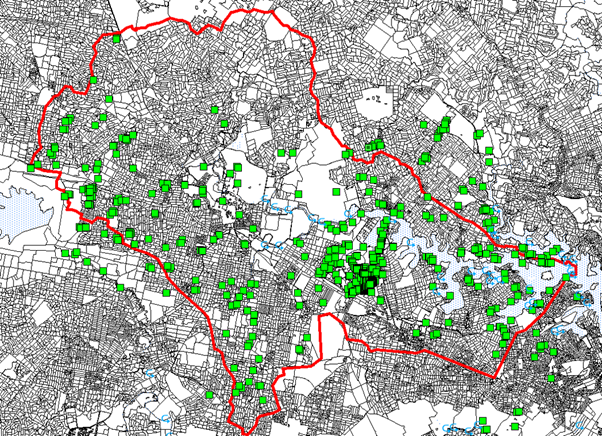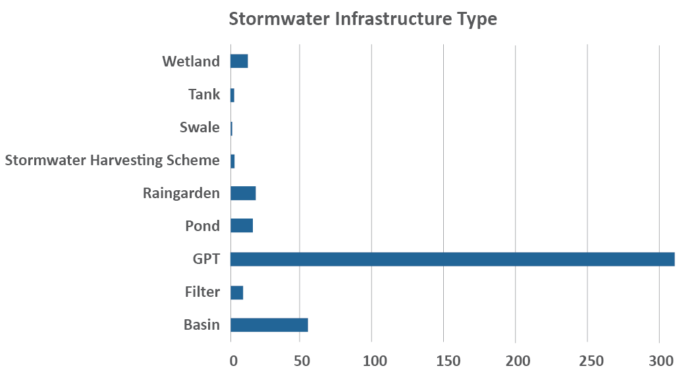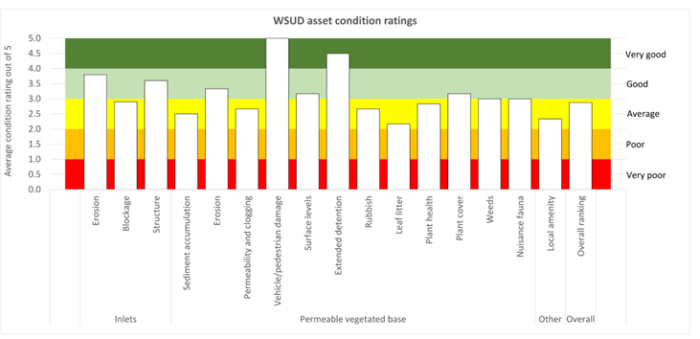5. Reduce stormwater runoff
Overview
Stormwater runoff has the potential to contribute large volumes of pollution into our waterways. We can combat this through the adoption of practices such as Water Sensitive Urban Design and a catchment-wide approach to reducing runoff reaching our waterways.
Recommendation
Adopt a regional approach to the installation, maintenance and reporting of stormwater infrastructure and water sensitive urban design (WSUD) infrastructure.
Timeframe
Ongoing.
Lead Agency
City of Parramatta and Sydney Water.
Current Measure
The workplan, as agreed by the subcommittee, is progressed on time and in budget.
Status Update
There are currently ten Councils, Transport for NSW, Roads and Maritime Services, Sydney Water and Sydney Olympic Park Authority (SOPA) that sit on a Stormwater Subcommittee which is dedicated to adopting a regional approach to the installation and maintenance of water sensitive urban design (WSUD) and stormwater infrastructure for the catchment. The annual workplan for the committee is broken down into four areas:
- Evidence base: this data is vital to prioritise future work and to model the effectiveness of current investment and stormwater management.
- Capacity building: uplift skills and knowledge within member organisations to address Step 5 outcomes.
- Funding sustainable stormwater management: additional sustainable funding for capital costs and operational costs of stormwater management, to meet the objectives of Steps 4 and 5.
- New tools and resources: develop supporting materials and explore new cross-organisational programs.
1. Developing the evidence base:
- We are auditing existing water sensitive urban design assets in the public and private realm to understand effectiveness of operations.
- Collecting information on location, condition and maintenance program of all gross pollutant traps, raingardens, wetlands and on-site stormwater devices across the Parramatta River catchment.
- Further information in PDF attachment (at end of this document).
2. Capacity Building:
- Share practices to uplift skills and knowledge within member organisations to build and manage green infrastructure that will treat stormwater before it enters our river and impacts on swim sites. Publish tools, research, share examples of projects and on-ground works.
- Developing educational materials for landholders and strata on management of stormwater management infrastructure on their lands. Including factsheets, webinars and videos.
3. Funding sustainable stormwater management:
- Investigating the efficacy of current investment in stormwater management.
- Reviewing council expenditure on stormwater infrastructure with a goal to adopt a regional outlook on investment. Working with stakeholders to identify sustainable funding opportunities.
- Regional WSUD compliance program.
4. New tools and resources:
- Ongoing implementation of the Litter Workplan.
- Developing standard WSUD operational and maintenance requirements for public and private WSUD assets.
- Standardised covenants and restrictions for stormwater management infrastructure
- Incorporating WSUD where appropriate for council areas, and improved stormwater management responses on roadways and parklands.
The Stormwater Subcommittee continues to meet on a regular basis. The priorities of the group centre around improving the capacity of councils to build and manage green infrastructure that will treat stormwater before it enters our river and impacts on swim sites. The Delivery Engine is working on pathways to fund more stormwater treatment infrastructure, as well as prioritising where infrastructure is required in the catchment.
SMART Places Acceleration Program – Smarter Cleaner Sydney Harbour for smart sensors in stormwater management
- The Smarter, Cleaner Sydney Harbour pilot will help authorities explore how smart technologies can help keep Sydney Harbour clean and healthy.
- The PRCG is partnering with CSIRO and Sydney Coastal Councils Group (SCCG) to conduct a larger trial of this technology in Sydney. The project involves the installation of approximately 80 sensors and cameras on GPTs and waterways across Sydney Olympic Park and seven local government areas within the Greater Sydney Harbour catchment, as well as the development of a web-based analysis, decision support and reporting tool.
- The project is supported through the NSW Smart Places Acceleration Program with a $545,000 grant provided by the NSW Digital Restart Fund. SOPA is acting as the NSW state agency co-partner on this project given Sydney Olympic Park has one of the highest concentrations of GPTs in Sydney.
- The project commenced in December 2022 and is expected to be completed in early 2024. The outcomes of the project will be considered in the preparation of the Greater Sydney Harbour Coastal Management Program as well as the implementation of the Greater Sydney Harbour Regional Litter Prevention Strategy.
- More information: www.sydneycoastalcouncils.com.au/projects/smarter-cleaner-sydney-harbour/
Stormwater Audit Results
Water Sensitive Urban Design (WSUD) is the broad collection of approaches to manage stormwater quality and runoff volumes to protect receiving waterways and create more green areas for the community. WSUD assets are held in public ownership and managed by council or the state government, or they are on-lot, that is held in private ownership to be operated and maintained by the individual.
Public Assets
In 2020 member councils and agencies were surveyed on publicly held WSUD assets. The committee is working to overcome the issues identified in the survey and to increase the catchment area in which stormwater is treated prior to its release to the Parramatta River.
Figure 1: Location of WSUD assets in the Parramatta River catchment
Figure 2: Types of WSUD assets in the catchment
Download the PRCG Stormwater Audit Results.
Private Assets Audit
In 2022 an audit of private stormwater devices was undertaken. The purpose of the audit was to:
a) understand how systems are being managed and maintained;
b) gain insight into property owners/tenants’ understanding of these stormwater management devices.
Fifty properties across seven LGAs were included in the audit, covering 254 assets. The audit report noted a number of specific issues, including poor property owner awareness of assets, poor design and construction and lack of ongoing maintenance.
The results of these inspections reveal that WSUD and OSD assets are working, but often ignored or not maintained. They are in general in average condition, and without a maintenance plan and budget, and may in the long term be a risk to the overall health of the river. These assets are providing some benefit to properties and lives from a flood management perspective, but this could be greatly improved with maintenance.
The auditing results of a total of 48 On-site Stormwater Devices (out of 254 assets across the 50 properties) were that overall, the OSD assets are functional (but only partially) but have very limited maintenance. It should also be noted that all OSD systems inspected were 15 years old or less, and that over that time, an unmaintained OSD will be increasingly likely to fail, leading to increased downstream flooding.
Of the 254 assets audited across the 50 properties, 171 were categorised as WSUD assets, and 18 included some type of vegetated filter. The rating of various parameters for these 18 WSUD assets is shown below.
In terms of the awareness and perception of property owners and strata managers, the main results from this project are shown below:
- Only 20% of assets are being maintained according to property owners
- 77% of property owners had no idea what these assets did (or did not respond)
- 15% knew when maintenance had been completed, and 9% stated that maintenance was completed in the past 12 months
- Just 3 of 50 property owners were able to estimate the costs of maintenance
- 5% of OSD devices had OSD name plates, and
- 14% of assets did not exist.
The committee is using the data gathered to focus efforts on policy change, education, alternative maintenance models, improved compliance and reporting and enforcing the use of covenants across the catchment.
Progress Timeline
December 2023 to February 2024
|
September to November 2023
|
June to August 2023
|
March – May 2023
|
December 2022 – February 2023
|
September – November 2022
|
June –August 2022
|
March – May 2022
|
September 2021 – February 2022
|
June – August 2021
|
March – May 2021
|
December 2020 – February 2021
|
September – November 2020
|
June – August 2020
|
March – May 2020
|
December 2019 – February 2020
|
September – November 2019
|
June – August 2019
|
March – May 2019
|
Useful Links
There are a number of resources and best practice examples currently in place for Water Sensitive Urban Design and stormwater infrastructure types:




